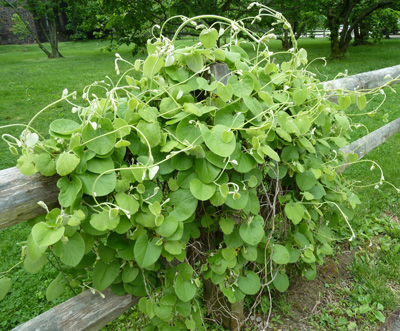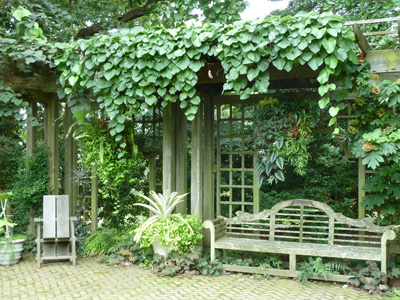 Sometimes a plant looks and performs so well that you take it for granted. Such a plant often isn’t flashy yet provides vital form, presence, or function to the garden. Case in point is the Aristolochia macrophylla covering a majority of the wooden arbor in the Terry Shane Teaching Garden. The vine is impressive in scale and provides a mid-height transition from ground level to the towering Quercus and Ulmus behind the garden.
Sometimes a plant looks and performs so well that you take it for granted. Such a plant often isn’t flashy yet provides vital form, presence, or function to the garden. Case in point is the Aristolochia macrophylla covering a majority of the wooden arbor in the Terry Shane Teaching Garden. The vine is impressive in scale and provides a mid-height transition from ground level to the towering Quercus and Ulmus behind the garden.
Aristolochia is a large genus with upwards of 500 members. The group, including evergreen and deciduous vines, as well as herbaceous perennials, is most commonly known as Dutchman’s pipe for the resemblance the flowers bear to meerschaum pipes that were once popular in Germany, the Netherlands, and other Northern European countries.
Two accessions are found on the arboretum grounds, Aristolochia macrophylla and Aristolochia tomentosa. The two species are very similar with the major difference being the fuzzy felt-like hairs that cover the leaves on A. tomentosa. This characteristic is especially noticeable on the new growth. Tomentose describes a plant surface covered with densely matted woolly hairs. The hairs are typically white or gray in coloration. Brushwood Nursery states that A. tomentosa tends to range farther into the Midwest and matures slightly smaller. Also, it tends to be more floriferous and bear slightly smaller leaves.
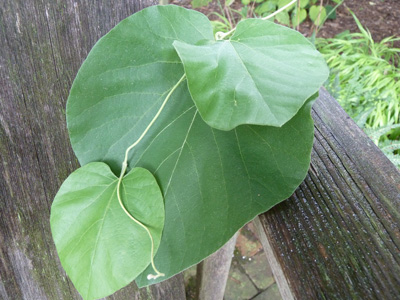
Leaves, 6-12” wide, orient themselves toward the sunlight providing an elegant and cool screen. photo credit: J. Coceano
Aristolochia macrophylla and A. tomentosa are eastern North American natives. The vine is commonly encountered along the Blue Ridge Parkway with a range spanning from Pennsylvania to Georgia and west to Kansas. Vines are capable of scrambling 20-40’ and produce woody stems with maturity. While the vine is a vigorous grower it is refined in habit. It doesn’t attempt to pull down its support or grow into it. Further evidence of its refinement and utility was the commonplace practice of growing either species as a living shade curtain on verandas and porches. The vine was trained up strings or lattice wherever shade and privacy was desired. Leaves, 6-12” wide, orient themselves toward the sunlight providing an elegant and cool screen.
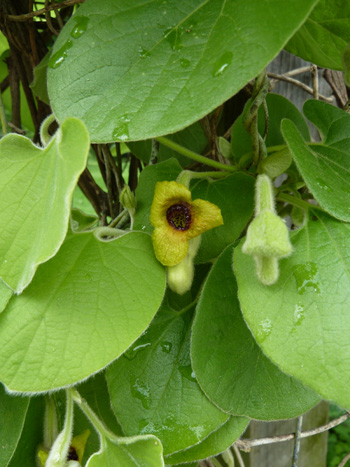
Known as Dutchman’s pipe for the resemblance the flowers bear to meerschaum pipes that were once popular in Germany, the Netherlands, and other Northern European countries. photo credit: J. Coceano
Culturally aristolochia performs best in full sun to partially shaded locations with ample moisture. Cut it back in late winter to control growth and prune any errant growth throughout the growing season as necessary. Keep an eye out for pipevine swallowtail butterflies, Battus philenor, as the caterpillars of the species feed strictly on Aristolochia species. Consuming the plant renders the caterpillars poisonous to any would-be consumer. As a result, many other butterfly species mimic the pipevine swallowtail and its black and iridescent blue coloration in the hopes of warding off predators. The monarch butterfly obtains similar protection by feeding on asclepias.
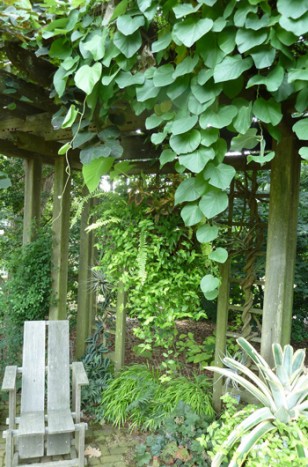
While the vine is a vigorous grower it is refined in habit. It doesn’t attempt to pull down its support or grow into it. photo credit: J. Coceano
Vines serve an important function in the landscape. They unify below with above and soften faces, slopes, and facades. We invite you to come and sit in the Terry Shane Teaching Garden and enjoy the shade cast by the Aristolochia macrophylla. Interested in other vines? Stroll through the arboretum and experience firsthand the diversity of this eager group of plants.

